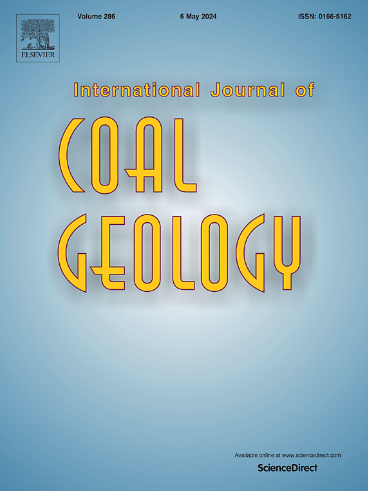丹麦北海云雀地层陆生植物和海洋藻类有机物质的有机岩石学和地球化学见解
IF 5.6
2区 工程技术
Q2 ENERGY & FUELS
引用次数: 0
摘要
从始新世到中新世的气候波动凸显了调查丹麦北海最新始新世到中新世云雀地层古环境的重要性。本研究利用从北海盆地东部七口井中采集的 54 份切屑样本和一份岩心样本,对云雀地层中的未成熟沉积有机物进行了调查。通过有机岩石学和分子地球化学分析,确定了同生和自生有机物的数量和来源变化。此外,该研究还评估了气候波动对北海盆地东部海洋生产力以及最近始新世至中新世期间盆地边缘陆地植物植被的影响。云雀地层中的有机质来源于混合来源,主要是陆地植物,其次是海洋藻类。这一点可以从大分子成分以及脂肪族和芳香族烃类生物标记化合物的类型和丰度中看出。此外,二萜类化合物(裸子植物生物标志物)和非跳类三萜类化合物(被子植物生物标志物)的存在表明,异源有机物来自针叶树和被子植物。陆地植物蜡质的平均链长(ACL)、针叶树的贡献比例(C/(C + A))以及腐植质、惰性石灰质(H + I,体积百分比)和石灰质(L,体积百分比)的整个岩石体积百分比等几个参数揭示了最近始新世到中新世期间气候对陆地植物和海洋藻类的影响。向更凉爽、更干燥气候的转变凸显了陆生针叶树对寒冷的适应性,并导致较高分子量的蜡质成分进入沉积物。然而,在这些条件下,降水和径流的减少导致向盆地提供的陆生有机物数量减少。此外,水温下降和当地藻类的暖亲和性也导致海洋生产力下降。这些因素共同导致有机物丰富度总体下降。与此相反,在向更温暖、更潮湿的气候转变期间,这一趋势发生了逆转。针叶树对花卉组合的贡献减少,但由于降水和径流的增加,更多的陆生有机物被输送到盆地。随之而来的是水温升高,提高了海洋环境中有机壁微型浮游生物的生产率,增加了有机物的丰富度。本文章由计算机程序翻译,如有差异,请以英文原文为准。
Organic petrographic and geochemical insights into organic matter derived from land plants and marine algae in the Lark Formation, Danish North Sea
Climatic fluctuations from the Eocene to the Miocene highlight the importance of investigating the paleoenvironment of the latest Eocene to the Middle Miocene Lark Formation in the Danish North Sea. This study investigates immature sedimentary organic matter in the Lark Formation using 54 cuttings samples and one core sample collected from seven wells in the eastern North Sea Basin. Organic petrography and molecular geochemistry analyses were performed to determine the variations in the quantity and origin of allochthonous and autochthonous organic matter. Additionally, the study assesses the impact of climate fluctuations on marine productivity in the eastern North Sea Basin and land plant vegetation at the basin margins during the latest Eocene to the Middle Miocene.
The organic matter in the Lark Formation originated from mixed sources, primarily land plants, with a secondary contribution from marine algae. This is indicated by the maceral composition and the types and abundance of aliphatic and aromatic hydrocarbon biomarker compounds. Moreover, the presence of diterpenoids (gymnosperm biomarkers) and non-hopanoid triterpenoids (angiosperm biomarkers) reveals that the allochthonous organic matter originated from conifers and angiosperms.
Climatic impacts on land plants and marine algae during the latest Eocene to the Middle Miocene are revealed by several parameters: the Averaged Chain Length (ACL) of land plant waxes, the proportion of coniferous contribution (C/(C + A)), and the whole rock volume percentages of huminite, inertinite (H + I, vol%) and liptinite (L, vol%). The shifts to cooler and drier climates highlighted the cold adaptation of onshore conifers and resulted in the input of higher molecular weight waxy components into the sediments. However, under these conditions, reduced precipitation and runoff resulted in lower amounts of terrigenous organic matter supplied to the basin. Additionally, the drop in water temperature and the warm-affinity of local algae assemblage led to reduced marine productivity. Together, these factors contributed to an overall decrease in organic richness. In contrast, during shifts to warmer and more humid climates, the trend reversed. The contribution of conifers to the floral assemblage diminished, but higher amounts of terrigenous organic matter were transported to the basin due to increased precipitation and runoff. This was accompanied by warmer water temperatures, boosting the productivity of organic-walled microplankton in the marine environment and contributing to greater organic richness.
求助全文
通过发布文献求助,成功后即可免费获取论文全文。
去求助
来源期刊

International Journal of Coal Geology
工程技术-地球科学综合
CiteScore
11.00
自引率
14.30%
发文量
145
审稿时长
38 days
期刊介绍:
The International Journal of Coal Geology deals with fundamental and applied aspects of the geology and petrology of coal, oil/gas source rocks and shale gas resources. The journal aims to advance the exploration, exploitation and utilization of these resources, and to stimulate environmental awareness as well as advancement of engineering for effective resource management.
 求助内容:
求助内容: 应助结果提醒方式:
应助结果提醒方式:


